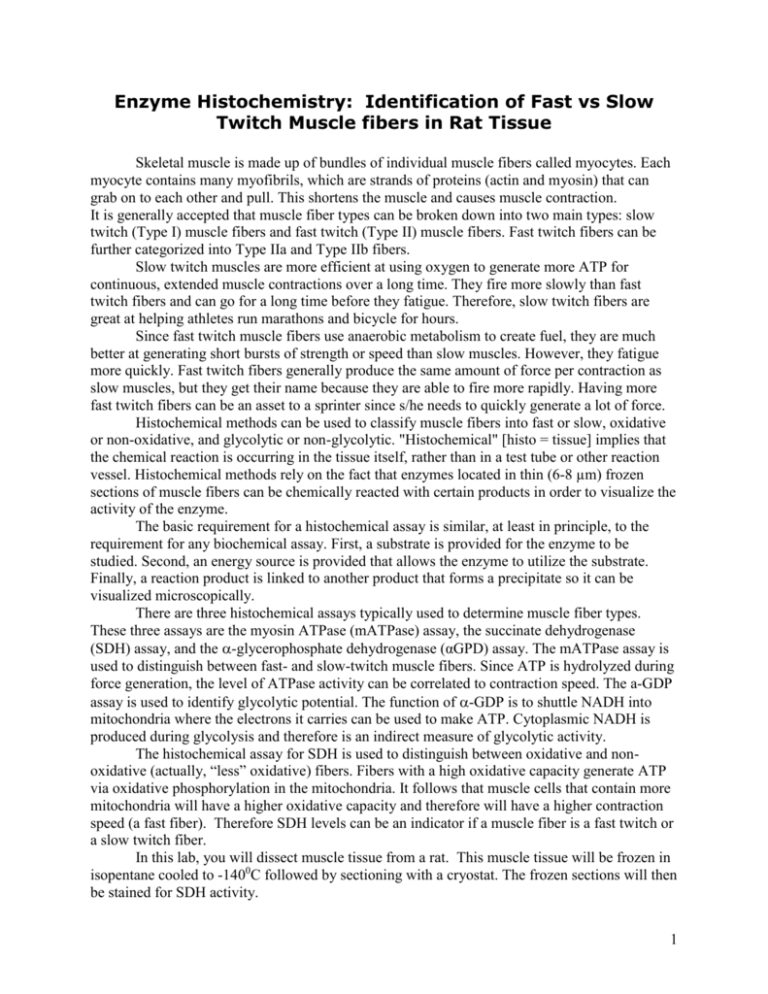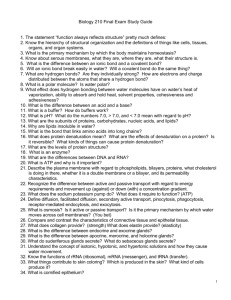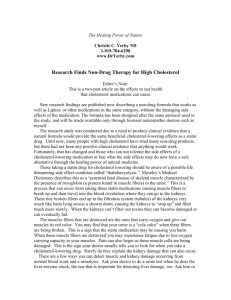Enzyme Histochemistry: Staining muscle cells for Succinate
advertisement

Enzyme Histochemistry: Identification of Fast vs Slow Twitch Muscle fibers in Rat Tissue Skeletal muscle is made up of bundles of individual muscle fibers called myocytes. Each myocyte contains many myofibrils, which are strands of proteins (actin and myosin) that can grab on to each other and pull. This shortens the muscle and causes muscle contraction. It is generally accepted that muscle fiber types can be broken down into two main types: slow twitch (Type I) muscle fibers and fast twitch (Type II) muscle fibers. Fast twitch fibers can be further categorized into Type IIa and Type IIb fibers. Slow twitch muscles are more efficient at using oxygen to generate more ATP for continuous, extended muscle contractions over a long time. They fire more slowly than fast twitch fibers and can go for a long time before they fatigue. Therefore, slow twitch fibers are great at helping athletes run marathons and bicycle for hours. Since fast twitch muscle fibers use anaerobic metabolism to create fuel, they are much better at generating short bursts of strength or speed than slow muscles. However, they fatigue more quickly. Fast twitch fibers generally produce the same amount of force per contraction as slow muscles, but they get their name because they are able to fire more rapidly. Having more fast twitch fibers can be an asset to a sprinter since s/he needs to quickly generate a lot of force. Histochemical methods can be used to classify muscle fibers into fast or slow, oxidative or non-oxidative, and glycolytic or non-glycolytic. "Histochemical" [histo = tissue] implies that the chemical reaction is occurring in the tissue itself, rather than in a test tube or other reaction vessel. Histochemical methods rely on the fact that enzymes located in thin (6-8 µm) frozen sections of muscle fibers can be chemically reacted with certain products in order to visualize the activity of the enzyme. The basic requirement for a histochemical assay is similar, at least in principle, to the requirement for any biochemical assay. First, a substrate is provided for the enzyme to be studied. Second, an energy source is provided that allows the enzyme to utilize the substrate. Finally, a reaction product is linked to another product that forms a precipitate so it can be visualized microscopically. There are three histochemical assays typically used to determine muscle fiber types. These three assays are the myosin ATPase (mATPase) assay, the succinate dehydrogenase (SDH) assay, and the -glycerophosphate dehydrogenase (αGPD) assay. The mATPase assay is used to distinguish between fast- and slow-twitch muscle fibers. Since ATP is hydrolyzed during force generation, the level of ATPase activity can be correlated to contraction speed. The a-GDP assay is used to identify glycolytic potential. The function of -GDP is to shuttle NADH into mitochondria where the electrons it carries can be used to make ATP. Cytoplasmic NADH is produced during glycolysis and therefore is an indirect measure of glycolytic activity. The histochemical assay for SDH is used to distinguish between oxidative and nonoxidative (actually, “less” oxidative) fibers. Fibers with a high oxidative capacity generate ATP via oxidative phosphorylation in the mitochondria. It follows that muscle cells that contain more mitochondria will have a higher oxidative capacity and therefore will have a higher contraction speed (a fast fiber). Therefore SDH levels can be an indicator if a muscle fiber is a fast twitch or a slow twitch fiber. In this lab, you will dissect muscle tissue from a rat. This muscle tissue will be frozen in isopentane cooled to -1400C followed by sectioning with a cryostat. The frozen sections will then be stained for SDH activity. 1 SDH is located in the inner membrane of the mitochondrion, bound to the cristae. SDH is responsible for oxidizing succinate to fumarate in the Kreb’s Cycle. As this reaction proceeds, succinate is oxidized, and the reduced form of NADH is produced. Succinate is therefore the substrate, NADH is the reaction product (actually, a different electron acceptor is used for practical reasons), and SDH is the enzyme. The electron acceptor is chemically reacted with nitro blue tetrazolium (NBT), a purple salt, to visualize the reaction, and this results in a speckled pattern of the mitochondria (Figure 1), proportional to the number of mitochondria and the SDH activity within them. Similar to the ATPase assay, the more SDH (and therefore mitochondria) a fiber contains, the greater the intensity of the stain. Oxidative fibers have a relatively dense, purple speckled appearance, while non-oxidative fibers have only scattered purple speckles. Therefore, this histochemical assay reflects the relative oxidative potential of muscle fibers. Purpose: The purpose of the this lab is to use a histochemical stain for a SDH to identify fast and slow muscle fibers in rat thigh muscle, determine the percentage of these fibers in the tissue and the average diameter of each fiber type. Fig. 1 Frozen section of skeletal muscle stained for SDH showing fast fibers (dark) and slow fibers (light). Retrieved from the World Wide Web at http://muscle.ucsd.edu/musintro/histochem.shtml on January 9, 2008 Procedure: 1. Freezing muscle specimens a. Dissect out muscle specimen. Suggestions would be abdominal or leg muscle. b. Rinse tissue in ice cold PBS to remove blood. Leave in PBS until ready to freeze. c. Place the plastic container into a larger plastic container. Fill the smaller container ½ full with isopentane (2-methylbutane). Slowly add small chips of dry ice to the isopentane. Watch out for boiling over. Keep adding dry ice until the isopentane stops boiling. d. Using forceps drop your tissue into the isopentane and allow to remain for about 15 sections. Then remove the specimen and place on the Saran wrap on dry ice. Don’t let the sample thaw. 2. Mounting specimen for sectioning a. Make sure the cryostat is set to -20oC. b. Transport the specimen to the cryostat on dry ice. c. Mount the specimen on a disk using freezing medium. 2 d. e. f. g. Allow the specimen to sit in the cryostat for 10 minutes to warm up. Section specimen at 8 m. Sections should be collected toward the bottom of the slide. Slides can be kept in a slide box until ready for staining. 3. Staining slides for SDH activity. a. Incubate sections for 30 minutes at 37oC in incubation medium placed in a Coplin jar. b. Rinse section in physiological saline. This can be done by dipping the slides several times in a Coplin jar containing the saline. c. Fix sections in 10% formalin-saline solution (Coplin jar) for 3-5 minutes. d. Rinse in 15% alcohol for 5 minutes (Coplin jar). e. Mount with an aqueous mounting medium and let sit for 2-3 minutes. f. Seal edges of cover slip with clear nail polish and let dry. g. View with a microscope. 0.2 M. Sodium phosphate monobasic 2.78 g/100 ml 0.2 M Sodium phosphate dibasic 5.37g/100ml 0.2 M Phosphate Buffer, pH 7.6 13 ml 0.2 M sodium phosphate monobasic 87 ml 0.2 M sodium phosphate dibasic Check pH and adjust to 7.6 using 1N NaOH or 1N HCL. Store in the refrigerator. 0.2 M Sodium succinate solution 2.70 g Sodium succinate (NaOCOCH2CH2COONa*6H20 50 ml dH20 Prepare fresh NBT solution 0.1 g NBT (Sigma # N-6876) 50 mls dH20 Make up only 50 ml at a time and store in the refrigerator. Incubation medium Just before use, mix: 5 ml 0.2 M phosphate buffer 5 ml sodium succinate solution 5 ml NBT solution 5 ml dH2O Physiological Saline 8.5 g NaCl 1 L dH2O Store at room temperature 3 10% Formalin-saline solution 45 ml physiological saline 5 ml 40% formaldehyde Prepare fresh each time 15% alcohol 15 ml ETOH 85 ml dH2O Buffered Glycerol mounting medium Either 0.1M Phosphate buffer (pH 7.4): 10 ml or 0.1M TRIS buffer (pH 9.0): 10 ml Anti-fading agent: Either p-Phenylenediamine hydrochloride: 100 mg or n-propyl gallate: 500 mg Glycerol: 90 ml Keeps for at least 3 months, probably much longer, in darkness (which protects the anti-fade agent) at -20C. The working bottle is kept at 4C, for a week or two. Data analysis: 1. Determine the percentage of fast vs slow fibers. 2. Determine the average diameter of fast and slow fibers. 3. Take a picture of your preparation. Lab report: 1. Write an abstract and a results section of your research including all necessary data properly presented. 2. Include a picture of your slide that includes a size marker. 3. Answer the following questions; a. For each of the following indicate its purpose. NBT Succinate Phosphate buffer Formalin-saline b. Why are some muscle fibers stained darker than others? c. Explain how this stain works to label mitochondria. d. What is the difference between fast and slow fibers? e. Why do muscle cells have these two different types of fibers? f. If you are an endurance runner, is it better have more fast fibers or slow fibers? Explain. This protocol was obtained at http://www.ihcworld.com/_protocols/histology/aqueous_mounting_medium.htm. Retrieved from the World Wide Web on January 10, 2008 This lab was adapted from Histotechnology: A Self-Instructional Text (1997) by Freida L Carson, ASCP Press, p. 265-267 4







